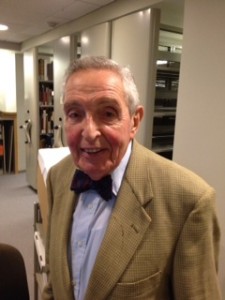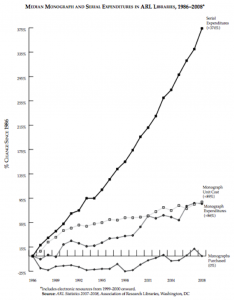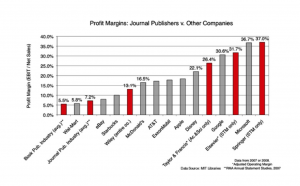When President Gerald Ford rebuffed New York City’s request for federal financial assistance in a financial crisis, The Daily News ran its famous headline October 29, 1975, “Ford to City: Drop Dead.” On a micro-level parallels between this situation and the one I discuss here are pretty slim, but that old headline can’t help but pop from memory. State and City support for the New York Public Library on behalf of public higher education has steadily eroded in good financial times, and in bad. In 2010 dollars, the $1 million the state provided in 1968 would equal $6.2 million today. We’re getting nowhere near that level of support. Here’s the story.
THEN…
Mina Rees, the first President of the CUNY Graduate School and University Center, upon finishing her 10-year term, wrote in 1972:
In 1968, a competent and interested group, assembled by the American Council of Learned Societies (ACLS) surveyed the problems of NYPL as well as the library needs of SUNY and CUNY and urged that substantial financial support be provided to NYPL by the City and State in exchange for increased New York Public Library support to the public universities.
“The Research Libraries of NYPL hold the necessary research materials for doctoral and postdoctoral research and their availability for such research could be significantly increased,” the report said. “But NYPL is increasingly threatened by deficits which face it with the alternatives of cutting into the endowment…or diminishing present services to research.”
The report envisioned such eventual major benefits to the universities (in addition to helping to insure the continuance of the research libraries) as the availability of tapes of future accessions, augmented bibliographical services, faster photoduplication and microfilming services, individual desks or carrels for doctoral and postdoctoral research, longer hours of service, and acquisition programs responding to the needs of SUNY and CUNY.
In the fiscal year 1968-69, the City responded to these recommendations by including $500,000 in the CUNY budget — to be matched by another $500,000 by the State — to provide for special services by NYPL to City University. Because full funding was not provided until the end of the fiscal year, the New York Public Library extended the arrangement to 1969-70. A few special services were granted to a limited number of faculty and students, including reserved study space in the Library’s 42nd Street Wertheim Room, where books may be paged and reserved for an extended period, and the use of a special Scholars’ Room in the Lincoln Center Library. Unfortunately, the City has not included the NYPL matching support item in the CUNY budget beyond the first year allotment. On an informal basis, a number of City University scholars still have access to the Wertheim and Lincoln Center Scholar’s Room, but the continuance of these special privileges and the granting of additional special assistance for the future are in doubt, as is the very survival of the research collections. The recent $500,000 matching federal grant from the National Endowment for the Humanities has provided some temporary relief for the Library, but adequate long-range financing is imperative.
The development of a permanent rapprochement between the Graduate School and the New York Public Library — with a long-range commitment of public funds under an agreement that would permit the university’s cooperation in the development of those NYPL policies that affect its research collections — should be one of the Graduate School’s top priorities for the near future.
Mina Rees. The First Ten Years of the Graduate School of the City University of New York. August 1972, p. 10.
NOW…
The NYPL lifted itself, largely through private funding, out of the economic lassitude (from the mid-1960s to the late 1980s) that threatened not only its greatness, but its very viability. CUNY managed to survive as well, growing in size and in transforming in academic stature to one of the great urban public universities. Mutual NYPL-CUNY accommodation has strengthened most notably in recent years with NYPL joining the IDS interlibrary loan network (in which SUNY and CUNY are primary participants), and with NYPL’s embrace of CUNY faculty and graduate students as its primary academic constituency in the MaRLI program, through which CUNY faculty and graduate students may borrow certain selected research collection titles for 8-week, renewable loans subject to recalls in the case of need by another borrower. But, New York State and City aid to these two great public institutions has remained stagnant.
New York State Government Aid for Library Services 2010-11
- In FY 2008 and prior, NYPL received a flat $2 million from New York State for CUNY Services which NYPL applied toward the purchase of research collection materials. This funding goes to NYPL’s General Book Fund.
- In FY 2009, the State made an initial across-the-board 2% reduction at budget adoption, as well as an additional 0.88% decrease during the year.
- In FY 2010, NYS included a 7% budget reduction across the board, and the mid-year deficit reduction plan included an across-the-board cut of 4.6%.
- The FY 2011 budget from NYS included an additional across-the-board reduction of 2.6%.
- The FY 2012 budget from NYS includes an across-the-board reduction of 6.5%. NYPL received 1.1 million for collections in support of CUNY Services. This could be reduced further if there is a mid-year cut
- CUNY Grad Students and Faculty currently constitute about 1/3 of the users of the NYPL’s 2nd floor Wertheim Study – 96 out of 290 total users in 2010 were CUNY affiliates (48 identified as faculty and 48 as doc students). About half of the CUNY Wertheim users are from the social sciences, most of the other half is from the humanities. A few (1-4/year) CUNY affiliates also enjoy Allen Room privileges. CUNY use of the NYPL Art Collection is also substantial, but no specific stats are available.
In 2012, the NYPL received the same $1 million from state that it did in the late 1960s to support research collections to benefit CUNY students. If $1 million in 2010 dollars were contributed to the 1968 budget, that would be a measly $161,385. We must insist that the state reverse erosion of its support for the New York Public Library. Our City’s Library, the most democratic of institutions supporting citizen patrons of CUNY and NYPL and visiting researchers from around the country and the world, deserves the support our tax dollars can provide.


